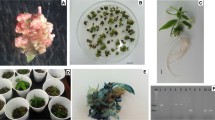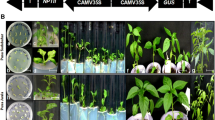Abstract
Genetic improvements of Eucalyptus require both breeding and gene transformation to generate desirable traits for forest industry. Because most of the current Eucalyptus transformation methods rely on juvenile seedling tissues as explants, the resulting transgenics are subjected to phenotypic segregation through the use of segregated seedlings. This is unsuitable for transformation of selected Eucalyptus breeding lines, especially the interspecific hybrids. Here, we developed an Agrobacterium-mediated transformation method using peeled nodal-stem explants from in vitro-propagated plantlets of a Eucalyptus hybrid. The explant was prepared by peeling off epidermal layers around the axillary buds using a pair of forceps, before co-cultivation with Agrobacterium tumefaciens. Transgenic shoots generated from the axillary buds were then obtained through kanamycin selection. The transformation efficiency was at most 24% as confirmed by PCR and GUS assay. Transformation of a E. camaldulensis × E. tereticornis F1 hybrid clone using yeast HAL2 showed that, out of 35, 11 transgenic plantlets had an increase in salt tolerance and grew and developed roots, though at a slow rate, on the medium supplemented with NaCl up to 300 mM concentration. This work demonstrates the efficiency of this transformation method for further genetic improvement of Eucalyptus clones selected through hybridization and breeding.




Similar content being viewed by others
References
Aggarwal D, Kumar A, Reddy MS (2011) Agrobacterium tumefaciens mediated genetic transformation of selected elite clone (s) of Eucalyptus tereticornis. Acta Physiol Plant 33(5):1603–1611. https://doi.org/10.1007/s11738-010-0695-3
Arrillaga I, Gil-Mascarell R, Gisbert C, Sales E, Montesinos C, Serrano R, Moreno V (1998) Expression of the yeast HAL2 gene in tomato increases the in vitro salt tolerance of transgenic progenies. Plant Sci 136(2):219–226. https://doi.org/10.1016/S0168-9452(98)00122-8
Bandyopadhyay S, Cane K, Rasmussen G, Hamill JD (1999) Efficient plant regeneration from seedling explants of two commercially important temperate eucalypt species—Eucalyptus nitens and E. globulus. Plant Sci 140(2):189–198. https://doi.org/10.1016/S0168-9452(98)00221-0
Cervera M, Ortega C, Navarro A, Navarro L, Pena L (2000) Generation of transgenic citrus plants with the tolerance-to-salinity gene HAL2 from yeast. J Hortic Sci Biotechnol 75(1):26–30
Chauhan RD, Veale A, Cathleen M, Strauss SH, Myburg A (2014) Genetic transformation of Eucalyptus-challenges and future prospects. In: Ramawat KG, Merillon JM, Ahuja MR (eds) Tree biotechnology. CRC Press, New York, pp 392–445
de la Torre F, Rodríguez R, Jorge G, Villar B, Álvarez-Otero R, Grima-Pettenati J, Gallego PP (2014) Genetic transformation of Eucalyptus globulus using the vascular-specific EgCCR as an alternative to the constitutive CaMV35S promoter. Plant Cell Tissue Organ Cult 117(1):77–84. https://doi.org/10.1007/s11240-013-0422-z
Dibax R, Deschamps C, Bespalhok Filho JC, Vieira LGE, Molinari HBC, De Campos MKF, Quoirin M (2010) Organogenesis and Agrobacterium tumefaciens-mediated transformation of Eucalyptus saligna with P5CS gene. Biol Plant 54(1):6–12. https://doi.org/10.1007/s10535-010-0002-6
Dower WJ, Miller JF, Ragsdale CW (1988) High efficiency transformation of E. coli by high voltage electroporation. Nucleic Acids Res 16(13):6127–6145
Ellul P, Rios G, Atares A, Roig LA, Serrano R, Moreno V (2003) The expression of the Saccharomyces cerevisiae HAL1 gene increases salt tolerance in transgenic watermelon [Citrullus lanatus (Thunb.) Matsun. & Nakai.]. Theor Appl Genet 107(3):462–469. https://doi.org/10.1007/s00122-003-1267-3
Feikema PM, Sasse JM, Bandara GD (2012) Chloride content and biomass partitioning in Eucalyptus hybrids grown on saline sites. New For 43(1):89–107
Gaiotto FA, Bramucci M, Grattapaglia D (1997) Estimation of outcrossing rate in a breeding population of Eucalyptus urophylla with dominant RAPD and AFLP markers. Theor Appl Genet 95(5–6):842–849
Girijashankar V (2011) Genetic transformation of Eucalyptus. Physiol Mol Biol Plants 17(1):9–23. https://doi.org/10.1007/s12298-010-0048-0
González ER, de Andrade A, Bertolo AL, Lacerda GC, Carneiro RT, Defávari VAP, Labate MTV, Labate CA (2002) Production of transgenic Eucalyptus grandis × E. urophylla using the sonication-assisted Agrobacterium transformation (SAAT) system. Funct Plant Biol 29(1):97–102. https://doi.org/10.1071/PP01142
Grattapaglia D, Kirst M (2008) Eucalyptus applied genomics: from gene sequences to breeding tools. New Phytol 179(4):911–929
Han MS, Noh EW, Han SH (2013) Enhanced drought and salt tolerance by expression of AtGSK1 gene in poplar. Plant Biotechnol Rep 7(1):39–47
Harfouche A, Meilan R, Altman A (2011) Tree genetic engineering and applications to sustainable forestry and biomass production. Trends Biotechnol 29(1):9–17
Harwood C (2014) Classical genetics and traditional breeding. In: Henry R, Kole C (eds) Genetics, genomics and breeding of Eucalypts. CRC Press, New York, pp 12–33
Ho CK, Chang SH, Tsay JY, Tsai CJ, Chiang VL, Chen ZZ (1998) Agrobacterium tumefaciens-mediated transformation of Eucalyptus camaldulensis and production of transgenic plants. Plant Cell Rep 17(9):675–680. https://doi.org/10.1007/s002990050754
Hood EE, Gelvin SB, Melchers LS, Hoekema A (1993) NewAgrobacterium helper plasmids for gene transfer to plants. Transgenic Res 2(4):208–218
Jefferson RA (1987) Assaying chimeric genes in plants: the GUS gene fusion system. Plant Mol Biol Rep 5(4):387–405
Jefferson RA, Kavanagh TA, Bevan MW (1987) GUS fusions: beta-glucuronidase as a sensitive and versatile gene fusion marker in higher plants. EMBO J 6(13):3901
Jiang J, Gill BS, Wang GL, Ronald PC, Ward DC (1995) Metaphase and interphase fluorescence in situ hybridization mapping of the rice genome with bacterial artificial chromosomes. Proc Natl Acad Sci USA 92(10):4487–4491
Madhibha T, Murepa R, Musokonyi C, Gapare W (2013) Genetic parameter estimates for interspecific Eucalyptus hybrids and implications for hybrid breeding strategy. New For 44(1):63–84
Matsunaga E, Nanto K, Oishi M, Ebinuma H, Morishita Y, Sakurai N, Suzuki H, Shibata D, Shimada T (2012) Agrobacterium-mediated transformation of Eucalyptus globulus using explants with shoot apex with introduction of bacterial choline oxidase gene to enhance salt tolerance. Plant Cell Rep 31(1):225–235. https://doi.org/10.1007/s00299-011-1159-y
Mullins KV, Llewellyn DJ, Hartney VJ, Strauss S, Dennis ES (1997) Regeneration and transformation of Eucalyptus camaldulensis. Plant Cell Rep 16(11):787–791. https://doi.org/10.1007/s002990050321
Murashige T, Skoog F (1962) A revised medium for rapid growth and bio assays with tobacco tissue cultures. Physiol Plant 15(3):473–497
Murguía JR, Belles JM, Serrano R (1995) A salt-sensitive 3′(2′),5′-bisphosphate nucleotidase involved in sulfate activation. Science 267(5195):232–234
Murguía JR, Bellés JM, Serrano R (1996) The yeast HAL2 nucleotidase is an in vivo target of salt toxicity. J Biol Chem 271(46):29029–29033. https://doi.org/10.1074/jbc.271.46.29029
Navarrete-Campos D, Bravo LA, Rubilar RA, Emhart Sanhueza R (2013) Drought effects on water use efficiency, freezing tolerance and survival of Eucalyptus globulus and Eucalyptus globulus × nitens cuttings. New For 44(1):119–134
Osakabe Y, Kajita S, Osakabe K (2011) Genetic engineering of woody plants: current and future targets in a stressful environment. Physiol Plant 142(2):105–117
Pantharug P (2002) In vitro propagation of E. camaldulensis Denh., E. citriodora Hook., E. cloeziana F. Muell., E. tereticornis Smith and E. urophylla S.T. Blake. M.Sc. thesis, Kasetsart University, Bangkok, Thailand
Peña L, Séguin A (2001) Recent advances in the genetic transformation of trees. Trends Biotechnol 19(12):500–506
Potts BM, Dungey HS (2004) Interspecific hybridization of Eucalyptus: key issues for breeders and geneticists. New For 27(2):115–138. https://doi.org/10.1023/A:1025021324564
Resende MD, Resende MF, Sansaloni CP, Petroli CD, Missiaggia AA, Aguiar AM, Abad JM, Takahashi EK, Rosado AM, Faria DA, Pappas GJ, Kilian A, Grattapaglia D (2012) Genomic selection for growth and wood quality in Eucalyptus: capturing the missing heritability and accelerating breeding for complex traits in forest trees. New Phytol 194(1):116–128
Rezende GDS, de Resende MDV, de Assis TF (2014) Eucalyptus breeding for clonal forestry. In: Fenning T (ed) Challenges and opportunities for the World’s forests in the 21st century. Springer, Dordrecht, pp 393–424
Siripatanadilok S, Thaiutsa B (1990) Application of vegetative propagation to improve timber yield of red gum (Eucalyptus camaldulensis Dehnh). Department of Forest Biology, Kasetsart University. Report No. 1, p 10
Tibok A, Blackhall NW, Power JB, Davey MR (1995) Optimized plant regeneration from callus derived from seedling hypocotyls of Eucalyptus urophylla. Plant Sci 110(1):139–145. https://doi.org/10.1016/0168-9452(95)04188-Z
Tournier V, Grat S, Marque C, El Kayal W, Penchel R, de Andrade G, Boudet AM, Teulières C (2003) An efficient procedure to stably introduce genes into an economically important pulp tree (Eucalyptus grandis × Eucalyptus urophylla). Transgenic Res 12(4):403–411
Wendling I, Trueman SJ, Xavier A (2014) Maturation and related aspects in clonal forestry—part II: reinvigoration, rejuvenation and juvenility maintenance. New For 45(4):473–486
Wilson C, Bellen HJ, Gehring WJ (1990) Position effects on eukaryotic gene expression. Annu Rev Cell Biol 6:679–714. https://doi.org/10.1146/annurev.cb.06.110190.003335
Woodward AJ, Bennett IJ (2005) The effect of salt stress and abscisic acid on proline production, chlorophyll content and growth of in vitro propagated shoots of Eucalyptus camaldulensis. Plant Cell Tissue Organ Cult 82(2):189–200
Yu X, Kikuchi A, Shimazaki T, Yamada A, Ozeki Y, Matsunaga E, Ebinuma H, Watanabe KN (2013) Assessment of the salt tolerance and environmental biosafety of Eucalyptus camaldulensis harboring a mangrin transgene. J Plant Res 126(1):141–150
Acknowledgements
This research was supported by The Graduate School for Thesis and Dissertation, Kasetsart University, Kasetsart University Research and Development Institute (KURDI), and Faculty of Science Research Fund (ScRF).
Author information
Authors and Affiliations
Corresponding authors
Ethics declarations
Conflict of interest
The authors declare that they have no conflict of interest.
Electronic supplementary material
Below is the link to the electronic supplementary material.
11056_2017_9621_MOESM1_ESM.tif
Supplementary data Fig. S1 shows vigorous growth of the 24A17 hybrid compared with its parental lines, E. calmaldulensis and E. tereticornis, and other two F1 hybrid lines (TIFF 10966 kb)
11056_2017_9621_MOESM2_ESM.tif
Supplementary data Fig. S2 shows growth of the 24A17 hybrid, E. calmaldulensis and E. tereticornis cultivated on the growth medium supplemented with 0, 100, 300 and 500 mM NaCl for 30 days (TIFF 9342 kb)
Rights and permissions
About this article
Cite this article
Thanananta, N., Vuttipongchaikij, S. & Apisitwanich, S. Agrobacterium-mediated transformation of a Eucalyptus camaldulensis × E. tereticornis hybrid using peeled nodal-stem segments with yeast HAL2 for improving salt tolerance. New Forests 49, 311–327 (2018). https://doi.org/10.1007/s11056-017-9621-5
Received:
Accepted:
Published:
Issue Date:
DOI: https://doi.org/10.1007/s11056-017-9621-5




